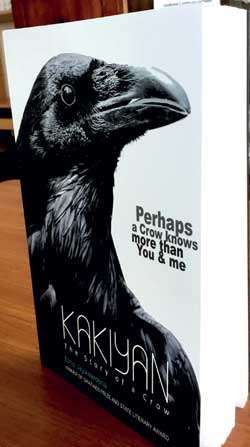04 Dec 2018 - {{hitsCtrl.values.hits}}
 Most people, asked to consider crows and their usefulness, if any, in our public life, would call them ‘scavengers’. I suppose that I might have done the same today, if I had not been invited by Elmo Jayewardene to edit his new novel for publication. Having completed that task and handed his manuscript back to its author, I can honestly say that I shall never again be able to see a crow or hear its “kaw!” without feelings of affection and deep respect.
Most people, asked to consider crows and their usefulness, if any, in our public life, would call them ‘scavengers’. I suppose that I might have done the same today, if I had not been invited by Elmo Jayewardene to edit his new novel for publication. Having completed that task and handed his manuscript back to its author, I can honestly say that I shall never again be able to see a crow or hear its “kaw!” without feelings of affection and deep respect.
Kakiyan must be one of the most endearing birds that ever entered the field of literature. He is certainly not the most beautiful. The crown of physical beauty has long been in the possession of the Peacock and the Ceylon Grackle, the second of whom scholars of Sinhala know as the Selalihini, the bird that Totagamuwe Sri Rahula, a scholar monk of the 15th century, chose to carry his poetic message, the Selalihini Sandesaya. “Don’t fly too high”, the poet warned his messenger in a famous passage, “or one of those sky-goddesses who frequent the clouds might see your sleek black feathers and golden wattles, and, mistaking you for a jewel or a flower, pluck you out of the sky and place you in her hair as an ornament.”
No such praise can ever come Kakiyan’s way. His plain black coat prevents that, and he knows it. Nor does he have the sweetest voice in the avian world: that prize has long been shared by two birds associated with English literature, Shelley’s Skylark and Keats’s Nightingale. The admirable thing about Jayewardene’s Sri Lankan hero – among his many other virtues, which include loyalty and a compassionate heart̶ is that he is totally lacking in envy and has no desire to borrow other birds’ feathers to enhance his own reputation. “Don’t mistake me for any high-flying Seagull, please!” he tells his reader. “My name is not Jonathan Livingston, it is Kakiyan the Crow, son of Stanley and Alice Crow, and brother of Rodney and Lucille.” A glance at an encyclopaedia will inform the reader that Sri Lanka’s Kakiyan is a scion of the ancient corvidae family, with an ancestry that goes back to the Raven that flew from Noah’s Ark in the time of the Great Flood, and has spread internationally – indeed, as far as the United States, where another raven inspired one of the best-known poems of Edgar Allan Poe. But you will never hear this from the author himself, for Kakiyan is a modest bird who plumes himself on nothing but his rare ability to tell an enthralling story and, at the same time, celebrate the wisdom of his community.
In reading the autobiography of this remarkable author, the reader gains a bird’s eye view of the human condition, for Kakiyan’s adventures have led him into law courts, football fields and many other places where people foregather, usually oblivious of the fact that a beady eye is trained upon their activities. His insights are valuable, his judgements reliable: he is not “just a crow”, he is a just crow. We have a lot to learn about our own world from Kakiyan, from his mother, the matriarch Alice Crow, from old Roy Crow, the optimist who unfailingly finds ‘the silver linings’ in every cloud, from his philosophical brother-in-law, the meditative Cameron (‘Cato’) Crow, and from all the other characters who fly in and out of his pages.
The crown of physical beauty has long been in the possession of the Peacock and the Ceylon Grackle, the second of whom scholars of Sinhala know as the Selalihini
Towards the end of this remarkable tour de force, this ‘Kaputu Kathawa’ of a twenty-first century crow, Kakiyan speculates about the after life: where will his last flight take him? As his admiring and grateful editor, I would say that he need have no worries about that. Cool, calm and confident, Jayewardene’s hero undeterred, will join the shining ranks of Heaven’s literary birds.
Yasmine Gooneratne
30 Nov 2024 15 minute ago
30 Nov 2024 2 hours ago
30 Nov 2024 5 hours ago
30 Nov 2024 6 hours ago
30 Nov 2024 9 hours ago